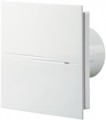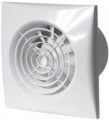Air flow (extraction)
This parameter describes the amount of air that the fan can pass through itself per hour when operating in extraction mode (see "Type"). It is one of the key characteristics of any extractor fan — it characterizes the overall performance and suitability of the unit for a particular room.
When choosing a fan for
maximum performance, two main indicators must be taken into account — the volume of the room and the air flow rate. The volume can be found by multiplying the area of the room by the height of the ceilings: for example, for a room of 12 m² in a residential apartment with standard ceilings of 2.5 m, this figure will be 12x2.5=30 m³. The air flow rate describes how many times per hour the air in an enclosed space must be completely replaced for ventilation to be sufficiently effective. This multiplicity is different for different types of premises: in particular, for the kitchen, it is 6-8, for the bathroom — 8-10, etc. More detailed values be found in specialized sources, in particular, sanitary standards. And the minimum required fan performance is calculated by multiplying the air volume by the air exchange rate. For example, if we have a bathroom with an area of 4 m² with the same ceiling of 2.5 m, then the volume of air in it will be 4x2=10 m³; Considering that the minimum air exchange rate for bathrooms is 7, for this room we need a fan with a capacity of at least 70 m³/h.
Rotational speed
The nominal fan speed during operation.
The rotational speed is one of the factors affecting the performance and, consequently, the overall efficiency of the fan. At the same time, this factor is far from being the only one. A lot also depends on the design of the blades, their number, the diameter of the impeller, etc. Therefore, fans with the same speed can differ significantly in capabilities, and you should pay attention primarily to performance.
At the same time, the rotation speed still has a certain practical significance. On the one hand, faster fans produce more noise; this drawback can be compensated to a certain extent by design tricks, but they, in turn, noticeably affect the price. On the other hand, to ensure the desired level of performance, lower-speed fans must either have impellers of a larger diameter (which accordingly affects the dimensions, and in most cases, the installation size) or, again, use design tweaks that affect the price.
Power consumption
The power consumed by the fan during normal operation.
This parameter primarily affects the power consumption of the device and the load on the power grid created during its operation. However, the latter is usually not critical, since the power of most modern fans is low. Also, the more powerful the device, the higher its performance(see above). However, there is no unambiguous dependence here — much is determined by how effective the design is. Therefore, models with the same performance can differ markedly in power consumption.
When choosing between two similar models with different power consumption, you should proceed with how often and for how long you plan to turn on the fan. If regular work is expected for a long time — for example, to ventilate the kitchen while cooking — you should pay attention to a less powerful model. It may cost more, but the price difference can quickly pay off in energy savings. If the fan turns on occasionally (for example, when installed in the bathroom of a residential apartment), you can not pay much attention to the power consumption.
Noise level
The noise level reproduced by the fan in normal operation.
The
lower the noise level, the more comfortable the use of the fan will be, the better it is suitable for rooms in which it is desirable to keep silence. In addition, there are certain regulations written in sanitary standards (for example, for residential premises during the day, a constant noise level of up to 40 dB is considered acceptable, and at night — up to 30 dB).
When choosing according to specific values recorded in the characteristics, it should be taken into account that the decibel used to measure the noise level is not a linear quantity: for example, an increase in sound power by 2 times corresponds to an increase of 3 dB, 10 times — by 10 dB, 100 times — by 20 dB. Therefore, to assess the noise level, it is easiest to refer to comparative tables, where the correspondence of specific values in decibels to various real sound sources is recorded. In most modern fans, noise is between 20 and 60 dB, here is the simplest table for this range:
20 – 25 dB — a weak audible sound, comparable to a whisper at a distance of 1 – 2 m;
25 – 30 dB — intelligible whisper at a short distance, ticking of a wall clock;
35 dB — muffled conversation;
40 – 45 dB — normal human speech;
50 – 55 dB — talking in raised tones, noise in the office;
60 dB — loud conversation at a distance of several metres.
Note that patter
...ns over 50 dB are rare; usually, these are “industrial” class units with a 400 V power supply and a large mounting diameter (see above), not intended for residential premises.Country of origin
The country specified as the manufacturer of the fan. Note that in most cases, this paragraph indicates the country of origin of the brand under which the unit was released. This country may not coincide with the place of production of individual components, or even with the final assembly place, and often such information is just a marketing ploy that plays on national stereotypes — for example, many consider German technology to be more reliable than Chinese. At the same time, these stereotypes are gradually losing relevance — in particular, due to the transfer of production mentioned above; and it makes sense when choosing to focus on reviews of real customers and the reputation of a particular brand, rather than on its national identity.
Now the following producing countries are represented on the market:
Germany,
Spain,
Italy,
China,
Latvia,
Lithuania,
Norway,
Poland,
Sweden.
Perimeter suction
A suction system that draws in air through a series of holes around the perimeter of the air intake. This design provides high suction efficiency and, at the same time, allows you to apply advanced design solutions to the device. Perimeter suction is characteristic mainly of models of the upper price range.
Cover height
The size of the decorative fan cover in height.
For details on the features of such panels in different types of fans, see "Cover diameter". The same size is indicated in cases where the panels are in the shape of a square or rectangle (see "Cover shape").
Cover width
The size of the decorative fan cover in width.
For details on the features of such panels in different types of fans, see "Cover diameter". The same size is indicated in cases where the panels are in the shape of a square or rectangle (see "Cover shape").
Cover thickness
The size of the decorative fan cover in thickness.
This parameter describes how much such a panel protrudes above the surface of the wall or ceiling on which the fan is installed. For more information about the general features of decorative panels in different types of fans, see "Cover diameter".

